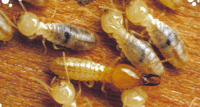How many termite species are there in Australia?
Of around three hundred species of termite in Australia, only about twenty are of economic importance in there own regions.
There are 3 main groups of structural timber destroying termites in Australia:
Subterranean, Drywood, & Dampwood termites
Dampwood termites belong to the family Kalotermitidae. These termites live inside the wood they eat and are rarely encountered in domestic homes.
Subterranean termites (families Rhinotermitidae and Termitidae) are much more common in urban areas, usually live in the soil & randomly forage for wood to eat.
Subterranean TermitesMastotermes |
Dampwood TermitesPorotermes Adamsoni |
Drywood TermitesCryptotermes |
Below are pictures of termite soldier caste heads of the important species that attack building structures in Australia
Click on photos to zooom


If termites are a problem for you, then we are your solution! We will rid your home or business these timber destroying pests that are causing you problems. Guaranteed!
If white-ants (its a misnomer, they are the same as termites) are a problem for you, please call us without delay on 0417 251 911, or send us a message for a free quote and advice about Pest Control Sydney& Metropolitan area in NSW
Differences between ants and termites
Picture of Coptotermes acinaciformis Termites
Australia’s most destructive and widespread termite, occurs throughout Australia with the exception of Tasmania (Tassie is almost free of structurally damaging termites because of the colder climate).
Body length is from 5.0mm to 6.6mm, is subterranean and arboreal, forms mounds in tropical regions. Coptotermes  acinaciformis can also build subsidiary nests away from the main colony. It has sabre-like mandibles with no obvious teeth apparent, the Labrum are not grooved.
acinaciformis can also build subsidiary nests away from the main colony. It has sabre-like mandibles with no obvious teeth apparent, the Labrum are not grooved.
The Copto’s head is rather pear-shaped and is rounded laterally. The fontanelle is used to shoot a white latex-like “glue” from its pronotum as a defence mechanism against enemies (usually ants). The fontanelle is obvious on the anterior part of the head. Its Tarsi has 4 segments and abdominal cerci have 2 segments. Like all termites, it may be identified from the Soldier caste and its workings. The workings appear to be fluted in the areas of activity. Soldier caste and workers live between 1-2 years.
